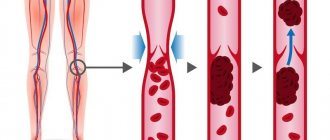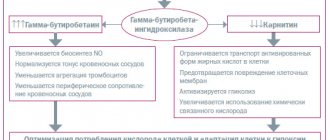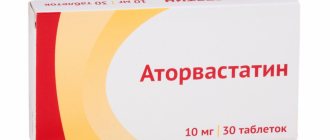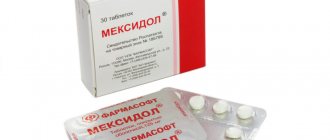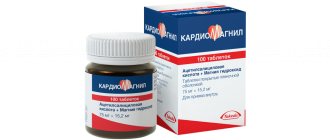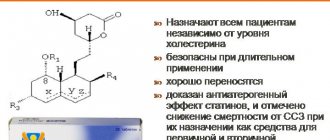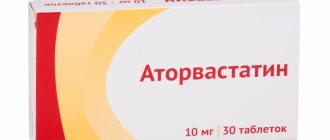The modern pharmaceutical industry provides a wide range of drugs for high cholesterol.
The most popular group of drugs among doctors and patients is statins. These are substances with a dual mechanism of action. They quickly and effectively reduce blood lipid levels and resolve atherosclerotic plaques. The article will discuss the main representative of statins - Atorvastatin, its analogues and substitutes, their advantages and disadvantages.
Choosing a manufacturer
Which manufacturer is better? Atorvastatin is produced by several Russian pharmaceutical companies, Kanonpharma, Vertex. is Israeli. How do the means differ? The difference between them lies in production technology, degree of purification and the quality of additional components of the drug.
The active ingredient is the same everywhere – atorvastatin. Atorvastatin Teva received good recommendations. The manufacturer pays special attention to the purification of both the main and additional components, which minimizes the risk of developing side effects described in the annotation for the drug.
An analogue is a medicine that contains the active ingredient of the original drug, but differs in the list of additional components. Below are the most well-known Atorvastatin substitutes.
Atoris
Atoris is one of the best analogs of Atorvastatin, which has received good recommendations from both doctors and patients. Produced by KRKA (Slovenia). The active ingredient is atorvastatin, which blocks the production of cholesterol by liver cells. Atoris belongs to the third generation drugs.
It is distinguished by high efficiency and a small number of side symptoms. You need to take the product once a day in the evening. The medicine is offered in the form of tablets with a dosage of 5/10/20/40 mg, packaged in 30/60/90 tablets per package. The cost of the product varies: from 300 to 900 rubles.
The leading contraindication for use is liver disease (acute and chronic form). If you have hepatitis or other liver problems, you should consult your doctor before starting therapy. During administration, it is necessary to monitor the level of transaminases in the blood serum.
No ads 1
Atorvastatin tablet p/pl/o 20 mg N30 (Pharmacist)
During treatment with HMG-CoA reductase inhibitors with simultaneous use of cyclosporine, fibrates, nicotinic acid in lipid-lowering doses (more than 1 g / day) or inhibitors of the CYP3A4 isoenzyme (for example, erythromycin, clarithromycin, antifungal agents - azole derivatives), the risk of myopathy increases (see . section "Special instructions"). Inhibitors of the CYP3A4 isoenzyme Since atorvastatin is metabolized by the CYP3A4 isoenzyme, combined use of atorvastatin with inhibitors of the CYP3A4 isoenzyme may lead to an increase in the concentration of atorvastatin in the blood plasma. The degree of interaction and potentiation effect is determined by the variability of the effect on the CYP3A4 isoenzyme. It was found that potent inhibitors of the CYP3A4 isoenzyme lead to a significant increase in the concentration of atorvastatin in the blood plasma. The simultaneous use of strong CYP3A4 isoenzyme inhibitors (for example, cyclosporine, telithromycin, clarithromycin, delavirdine, stiripentol, ketoconazole, voriconazole, itraconazole, posaconazole and HIV protease inhibitors, including ritonavir, lopinavir, atazanavir, indinavir, darunavir, etc.) should be avoided whenever possible. If concomitant use of these drugs is necessary, consider reducing the initial and maximum dose of atorvastatin. Moderate inhibitors of the CYP3A4 isoenzyme (for example, erythromycin, diltiazem, verapamil and fluconazole) may lead to increased plasma concentrations of atorvastatin. With the simultaneous use of HMG-CoA reductase inhibitors (statins) and erythromycin, an increased risk of developing myopathy was noted. Interaction studies between amiodarone or verapamil and atorvastatin have not been conducted. Both amiodarone and verapamil are known to inhibit the activity of the CYP3A4 isoenzyme, and concomitant use of these drugs with atorvastatin may lead to increased atorvastatin exposure. In this regard, it is recommended to reduce the maximum dose of atorvastatin and carry out appropriate monitoring of the patient's condition when used simultaneously with moderate inhibitors of the CYP3A4 isoenzyme. Monitoring should be carried out after the start of therapy and against the background of changing the dose of the inhibitor. Inhibitors of the OATP1B1 transport protein Atorvastatin and its metabolites are substrates of the OATP1B1 transport protein. OATP1B1 inhibitors (eg, cyclosporine) may increase the bioavailability of atorvastatin. Thus, the combined use of atorvastatin at a dose of 10 mg and cyclosporine at a dose of 5.2 mg/kg/day leads to an increase in the concentration of atorvastatin in the blood plasma by 7.7 times. The effect of inhibition of hepatic uptake transporter function on the concentration of atorvastatin in hepatocytes is unknown. If it is impossible to avoid the simultaneous use of such drugs, it is recommended to reduce the dose and monitor the effectiveness of therapy. Gemfibrozil/fibrates With the use of fibrates in monotherapy, adverse reactions, including rhabdomyolysis, affecting the musculoskeletal system were periodically noted. The risk of such reactions increases with simultaneous use of fibrates and atorvastatin. If the simultaneous use of these drugs cannot be avoided, the minimum effective dose of atorvastatin should be used. and patients should be regularly monitored. Ezetimibe The use of ezetimibe is associated with the development of adverse reactions, including rhabdomyolysis from the musculoskeletal system. The risk of such reactions increases with simultaneous use of ezetimibe and atorvastatin. For such patients, careful monitoring is recommended. Erythromycin/clarithromycin With simultaneous use of atorvastatin and erythromycin (500 mg 4 times a day) or clarithromycin (500 mg 2 times a day), inhibitors of the CYP3A4 isoenzyme, an increase in the concentration of atorvastatin in the blood plasma was observed (see section "Special instructions") . Protease inhibitors The simultaneous use of atorvastatin with protease inhibitors, known as CYP3A4 isoenzyme inhibitors, is accompanied by an increase in the concentration of atorvastatin in the blood plasma. Diltiazem The combined use of atorvastatin at a dose of 40 mg with diltiazem at a dose of 240 mg leads to an increase in the concentration of atorvastatin in the blood plasma. Cimetidine No clinically significant interaction was found between atorvastatin and cimetidine. Itraconazole Concomitant use of atorvastatin at doses of 20 mg to 40 mg and itraconazole at a dose of 200 mg led to an increase in the AUC value of atorvastatin. Grapefruit juice Since grapefruit juice contains one or more components that inhibit the CYP3A4 isoenzyme, excessive consumption (more than 1.2 L per day) may cause an increase in plasma concentrations of atorvastatin. Inducers of the CYP3A4 isoenzyme: Concomitant use of atorvastatin with inducers of the CYP3A4 isoenzyme (for example, efavirenz, rifampicin or St. John's wort preparations) may lead to a decrease in the concentration of atorvastatin in the blood plasma. Due to the dual mechanism of interaction with rifampicin (inducers of the CYP3A4 isoenzyme and inhibitor of the hepatocyte transport protein OATP1B1), simultaneous use of atorvastatin and rifampicin is recommended, since delayed administration of atorvastatin after taking rifampicin leads to a significant decrease in the concentration of atorvastatin in the blood plasma. However, the effect of rifampicin on the concentration of atorvastatin in hepatocytes is unknown and if concomitant use cannot be avoided, the effectiveness of this combination should be carefully monitored during therapy. Antacids Simultaneous oral administration of a suspension containing magnesium hydroxide and aluminum hydroxide reduced the plasma concentration of atorvastatin by approximately 35%. however, the degree of reduction in LDL-cholesterol concentrations did not change. Phenazine Atorvastatin does not affect the pharmacokinetics of phenazone, so interaction with other drugs metabolized by the same cygochrome isoenzymes is not expected. Colestipol With simultaneous use of colestipol, the concentration of atorvastatin in the blood plasma decreased by approximately 25%; however, the lipid-lowering effect of the combination of atorvastatin and colestipol was superior to that of each drug alone. Digoxin With repeated administration of digoxin and atorvastatin at a dose of 10 mg, the equilibrium concentrations of digoxin in the blood plasma did not change. However, when digoxin was used in combination with atorvastatin at a dose of 80 mg/day, digoxin concentrations increased by approximately 20%. Patients receiving digoxin in combination with atorvastatin require appropriate monitoring. Azithromycin With simultaneous use of atorvastatin at a dose of 10 mg 1 time per day and azithromycin at a dose of 500 mg 1 time per day, the concentration of atorvastatin in the blood plasma did not change. Oral contraceptives When atorvastatin was co-administered with oral contraceptives containing norethisterone and ethinyl estradiol, significant increases in the AUC of norethisterone and ethinyl estradiol by approximately 30% and 20%, respectively, were observed. This effect should be taken into account when choosing an oral contraceptive for women taking atorvastatin. Terfenadine With simultaneous use of atorvastatin and terfenadine, no clinically significant changes in the pharmacokinetics of terfenadine were detected. Warfarin In a clinical study in patients regularly receiving warfarin therapy, concomitant use of atorvastatin 80 mg daily resulted in a slight increase in prothrombin time of approximately 1.7 seconds during the first 4 days of therapy. The indicator returned to normal within 15 days of atorvastatin therapy. Although significant interactions affecting anticoagulant function have been observed only in rare cases, the prothrombin time should be determined before initiating atorvastatin therapy in patients receiving coumarin anticoagulant therapy and frequently enough during therapy to prevent a significant change in the prothrombin time. Once stable prothrombin time values are observed, its monitoring can be carried out in the same way as recommended for patients receiving coumarin anticoagulants. When changing the dose of atorvastatin or discontinuing therapy, prothrombin time should be monitored according to the same principles as described above. Atorvastatin therapy was not associated with bleeding or changes in prothrombin time in patients not receiving anticoagulant treatment. Colchicine Although studies have not been conducted on the simultaneous use of colchicine and atorvastatin, there are reports of the development of myopathy with the use of this combination. Caution should be exercised when atorvastatin and colchicine are used concomitantly. Amlodipine With simultaneous use of atorvastatin at a dose of 80 mg and amlodipine at a dose of 10 mg, the pharmacokinetics of atorvastatin at steady state did not change. Fusidic acid During post-marketing studies, cases of rhabdomyolysis have been reported in patients taking concomitant statins, including atorvastagin, and fusidic acid. The mechanism of this interaction is unknown. In patients for whom the use of fusidic acid is considered necessary, statin treatment should be discontinued for the entire period of use of fusidic acid. Statin therapy can be resumed 7 days after the last dose of fusidic acid. In exceptional cases where long-term systemic therapy with fusidic acid is necessary, for example for the treatment of severe infections, the need for concomitant use of atorvastatin and fusidic acid should be considered on a case-by-case basis and under close medical supervision. The patient should seek immediate medical attention if symptoms of muscle weakness, tenderness, or pain occur. Other concomitant therapy In clinical studies, atorvastatin was used in combination with antihypertensive agents and estrogens as part of hormone replacement therapy. There were no signs of clinically significant adverse interactions; No interaction studies with specific drugs have been conducted. In addition, an increase in the concentration of atorvastatin was observed when used simultaneously with HIV protease inhibitors (combinations of lopinavir and ritonavir, saquinavir and ritonavir, darunavir and ritonavir, fosamprenavir, fosamprenavir with ritonavir and nelfinavir), hepatitis C protease inhibitors (boceprevir), clarithromycin and itraconazole. Caution should be exercised when using these drugs together and the lowest effective dose of atorvastatin should be used.
Liprimar
The drug is offered in the form of tablets with a dosage of 10/20 mg. A package may contain 14–100 pills. This is very convenient if the patient is just starting to take this Atorvastatin substitute. A small package of 14 tablets helps to assess the tolerability of the drug and decide on the possibility of further use. You need to take the tablet in the recommended dosage in the evening.
Liprimar is manufactured by the German pharmaceutical company Pfizer.
Contraindications:
- any trimester of pregnancy;
- breastfeeding period;
- diabetes mellitus, impaired glucose tolerance.
Important! Liprimara is prescribed with caution in the presence of chronic allergies and liver pathologies.
When diagnosing atherosclerosis in patients over 70 years of age, the dosage is calculated individually. Self-administration of the drug by elderly patients is strictly prohibited. The cost of the medicine is 500–1000 rubles.
Introduction
Cardiovascular diseases (CVDs) continue to be the leading cause of death worldwide.
Thus, in the Russian Federation, mortality from CVD in 2017 was 587.6 cases per 100 thousand population with the initial registration of 4 million 706 thousand patients with diseases of the circulatory system [1]. The global burden of obesity, diabetes mellitus (DM), metabolic syndrome and hyperlipidemia is constantly increasing and may become the largest known non-infectious pandemic, which will subsequently lead to a huge increase in atherosclerotic CVD. The development of CVD largely depends on modifiable risk factors, but in clinical practice often insufficient efforts are made to normalize body weight, correct blood glucose levels, and low-density lipoprotein cholesterol (LDL-C) levels.
Hyperlipidemia is one of the leading risk factors for the development of CVD. According to European and Russian guidelines, first-line drugs for the treatment of hyperlipidemia that have demonstrated their effectiveness in reducing cardiovascular morbidity and mortality are statins (3-hydroxy-3-methylglutaryl-coenzyme A reductase [HMG-CoA reductase] inhibitors) [ 2, 3].
Prescribing adequate lipid-lowering therapy helps slow the progression of atherosclerosis and, as a consequence, prevent the development of CVD, patient disability, as well as reduce the frequency of re-hospitalizations for the purpose of myocardial revascularization, however, the success of statin use largely depends on the patient’s adherence to treatment.
Atorvastatin (Liprimar) is a synthetic drug from the statin group, approved by the US Food and Drug Administration in 1996. It is one of the most effective, studied, prescribed and sold drugs of this class. Atorvastatin competitively inhibits HMG-CoA reductase, which converts 3-hydroxy-3-methylglutaryl-CoA to mevalonate, and thereby reduces cholesterol production in the liver. In addition, atorvastatin also increases the number of LDL cholesterol receptors on the surface of liver cells.
Atorvastatin is approved for the treatment of adults with primary hyperlipidemia (heterozygous familial and non-familial), mixed dyslipidemia, hypertriglyceridemia, primary dysbetalipoproteinemia, homozygous familial hypercholesterolemia, as well as in children with heterozygous familial hypercholesterolemia, if it is impossible to achieve target LDL cholesterol levels on diet [4] . In patients with homozygous and heterozygous hypercholesterolemia, mixed dyslipidemia, isolated hypertriglyceridemia and non-familial hypercholesterolemia, this member of the statin class reduces the levels of total cholesterol, LDL cholesterol, apolipoprotein, very low-density lipoprotein cholesterol and triglycerides while increasing the level of high-density lipoprotein cholesterol. In patients with dysbetalipoproteinemia, atorvastatin reduces intermediate-density lipoprotein cholesterol levels.
Numerous large-scale clinical trials (GREACE, TNT, MIRACL, AVERT, etc.) have repeatedly demonstrated the effectiveness of the original atorvastatin in the primary and secondary prevention of CVD [5–8]. Thus, atorvastatin is used for primary prevention in patients without coronary artery disease (CHD), as well as in patients with type 2 diabetes mellitus (DM) without CHD, but with several risk factors for developing CVD, to reduce the risk of myocardial infarction (MI), stroke, angina pectoris and surgical treatment of coronary artery disease. This drug is indicated in patients with coronary artery disease as secondary prevention to prevent non-fatal myocardial infarction, fatal and non-fatal stroke, revascularization procedures, hospitalizations for congestive heart failure and angina pectoris [4].
According to current recommendations, atorvastatin therapy should be continued indefinitely in patients. Titration of drug doses is carried out until target LDL cholesterol levels are achieved, provided there are no side effects. Current guidelines suggest moderate-intensity (10–20 mg) or high-intensity (40–80 mg) atorvastatin therapy, depending on the patient's cardiovascular risk [2, 3, 9]. Thus, moderate-intensity statins should reduce LDL cholesterol levels by about 30-50%, while high-intensity doses should reduce LDL cholesterol levels by more than 50%. A decrease in LDL cholesterol levels by 1 mmol/L is accompanied by a reduction in the risk of cardiovascular events by approximately 20%, and further reductions in cholesterol levels with more intensive regimens lead to an even more pronounced reduction in the risk of developing CVD [10]. If target LDL cholesterol levels are not achieved, patients are advised to add new lipid-lowering drugs to therapy, such as ezetimibe, inhibitors of proprotein convertase subtilisin/kexin type 9 (PCSN9), which in a relatively short time reduce the risk of developing cardiovascular disease. vascular events [11, 12].
Torvacard
Torvacard tablets
An analogue of Atorvastatin from the Czech manufacturer, ZENTIVA. Included in the group of third generation statins. The suggested dosage of tablets is 10/20/40 mg. The package contains 30/90 tablets. The cost of the product is 400–1200 rubles. The drug is especially effective in the following cases:
- the need to control and normalize cholesterol levels after surgery on the hearts and blood vessels;
- treatment of severe stages of atherosclerosis (in this case, combined with fibrates and bile acid sequestrants).
After surgery, the duration of the course of use is one to three months, for atherosclerosis - for the rest of life. According to the instructions for use, you need to take the tablet in the recommended dosage once a day.
Indications for use
Advertising:
The indications for all hyperlipidemic drugs are the same; there is no difference in this matter. Based on the name and action, the main indication is high cholesterol, which is detected by donating blood on an empty stomach.
The drugs are recommended by a doctor for use if there are no results from a “fat-burning” diet.
Atorvastitin is also widely used to prevent complications of atherosclerosis that occur without treatment of the disease. These include thrombosis, stroke, and heart attack. All these pathologies are caused by the detachment of plaques and blockage of important vessels in the brain or heart. A special feature of the drug is its high effectiveness in hereditary hyperlipidemia, which is difficult to correct with other drugs. This group includes the following pathologies:
- primary hypercholesterolemia;
- hypertriglyceridemia;
- complex hypercholesterolemia;
- familial hypercholesterolemia of homozygous, heterozygous type.
Also, the medicine must be prescribed after a stroke or heart attack to prevent relapse, in severe cases of hypertension. With the correct dose selection, the pharmaceutical drug can be taken by children, adults, and the elderly.
Tulip
Generic Atorvastatin from the Slovenian pharmacists of the Sandoz company. Available in tablet form in dosages of 5/10/20 mg. Packed in 30 tablets. The price is variable (depending on the amount of active ingredient) - 300–500 rubles. Before starting treatment, a biochemical blood test is required.
The doctor evaluates liver function - the content of transaminases (ALT and AST). Liver disease is indicated by a deviation from the physiological norm. In this case, taking the drug will be prohibited. For elderly patients (over 70 years old), the dosage of the drug is calculated individually. The dosage regimen is standard - 1 tablet in the prescribed dosage in the evening, before bedtime.
No ads 2
Instructions for use
Carrying out therapy does not lead to the need to cancel the diet. It is important to simultaneously reduce the intake of animal fats from the outside, which is achieved by increasing the proportion of plant foods in the diet.
Advertising:
The dose of the drug is set strictly individually; it depends on the level of cholesterol, duration and type of disease, and the presence of a hereditary predisposition. As therapy progresses, the dose is adjusted depending on the reaction to the drug. The admission rules are as follows:
- initial dose - 10 mg;
- reception is carried out once a day;
- duration of treatment is 14-28 days, after which tests should be taken to evaluate the effectiveness of therapy;
- after the specified time, the dose can be increased;
- the maximum dose is 80 mg.
Atorvastatin should not be taken simultaneously with food, as its absorption is reduced. The difference with Rosuvastatin is that taking the latter does not depend on food intake. This may seem better and more convenient to some patients. In general, the drug in question is 10% less effective than Rosuvastatin, which can be taken in a lower dosage.
Atorvastatin-Teva
Dosage of the product – 5/10/20/40 mg. The package may contain 30/60/90 tablets. The cost of the product is 180–700 rubles. This analog of Atorvastatin is used as part of the main treatment regimen for atherosclerosis, and also prevents its formation in the post-infarction/postoperative period.
The manufacturer of the drug is the Israeli form Teva
Before starting to take the drug, older people should consult with their doctor. Otherwise, treatment may negatively affect the condition of the liver.
Other analogues of Atorvastatin
Advertising:
There are a number of foreign and domestic analogues with the same active substance. There is no point in looking for a cheaper drug - Atorvastatin has the lowest price among synonyms for the active ingredient. Imported drugs are much more expensive. Below are analogues containing atorvastatin:
| A drug | Number of tablets/dosage | Price, rubles |
| Tulip | 30/10 mg | 280 |
| Torvacard | 30/10 mg | 310 |
| Atoris | 30/10 mg | 420 |
| Liprimar | 30/10 mg | 780 |
| Caduet with amlodipine | 30/10 mg | 1120 |
The price for a similar package of Rosuvastatin is also much higher - 260 rubles. It is impossible to replace drugs without dose adjustment and without medical prescription, since Rosustastatin is usually used in more complex cases of hyperlipidemia. During treatment with any medication, liver function tests should be monitored every 1-3 months.
Novostat
The drug is produced by the Russian pharmaceutical company Atoll. Release form: capsules in a dosage of 10 mg. Packaging – 30/60/100 capsules per package. The cost of Novostat is 300–400 rubles. Thanks to the encapsulated form, the medicine is distinguished by high bioavailability. The active ingredient is not destroyed in the stomach, since the capsule does not dissolve in its aggressive environment.
The release of the drug occurs after the capsule passes into the lumen of the small intestine. The active substance penetrates the general bloodstream, then into the liver, where it begins to actively “work”. Novostat can be safely used for gastric ulcers and various forms of gastritis, since the drug does not irritate the damaged mucosa.
Atorvastatin – SZ
Dosage of the product – 5/10/20/40 mg. Cost – 150–200 rubles. Before starting use, it is necessary to exclude liver pathologies. This requires a biochemical blood test, as well as subsequent monitoring of ALT and AST levels.
The prefix SZ stands for North Star - a Russian pharmaceutical company that produces another analogue of Atorvastatin
Anvistat
The medicine is produced by the domestic pharmaceutical company Antiviral. Dosage – 10/20 mg. The package contains 30 tablets. Anvistat is a third generation statin. Effective against high cholesterol and helps normalize its level. Typically, the average course duration is a full calendar month.
No ads 3
You need to take the product in the evenings. Before starting treatment, it is necessary to exclude any problems with liver function. An effective replacement for Atorvastatin - if necessary - can be quickly selected. But what can replace the medicine must be decided by a specialist.
Reviews
Reviews about analogues of the drug are mostly positive. But since the active ingredient in all drugs is atorvastatin, the development of side effects cannot be ruled out. The development of unpleasant symptoms is influenced by the degree of purification of the active substance and the “purity” of additional components.
Oleg, 32 years old: On the doctor’s recommendation, after discovering high cholesterol, I started taking Atoris. The product helped me and my indicators returned to normal.
Elena Nikolaevna, 54 years old: I took Atorvastatin-SZ for a long course. I noticed an improvement in my well-being - I had coronary artery disease and angina attacks due to high cholesterol - about six months after I started taking it.
Natalya, 56 years old: After the operation, in order to prevent the development of atherosclerosis, I was prescribed Atorvastatin-Teva. The product was tolerated well, there were no side effects.
Action of Atorvastatin
After oral administration, the tablets bind to coenzyme A receptors at the site where the special enzyme HMG-CoA reductase is attached, blocking its production. This enzyme is present in the liver and is directly involved in the production of cholesterol. In parallel, the drug works in a different direction - the process of converting intermediate products into cholesterol is inhibited. The results are:
- reducing the presence of cholesterol in cells;
- accelerating the breakdown of existing cholesterol into the most harmful low-density lipoproteins.
It is these lipoproteins, at elevated levels, that cause the development of atherosclerosis. Taking the medicine helps reduce the rate of progression of the disease. At the same time, “good” high-density cholesterol increases. It removes fats from cholesterol plaques and helps process them in the liver. Symptoms of the disease decrease, and the risk of cardiac death also decreases. Other actions of the drug:
Qi-Klim is considered an antimenopausal drug, which is prescribed to women in menopause and in the premenopausal period. Its effectiveness has been proven by many reviews - the tablets really help to overcome unpleasant symptoms. Read more in the article: “Qi-Klim tablets indications for use.”
WE RECOMMEND THE ARTICLE!
Flax oil replenishes the body's needs for Omega-3 and vitamin E. Read more >>
- improvement of the condition of the vascular wall;
- optimization of blood flow;
- antioxidant effect.
Metabolites of the drug are processed in the liver, from where they are excreted naturally with bile. The difference between Rosuvastatin is that its residues are excreted unchanged in the feces.
In diseases of the joints and spine, severe muscle stiffness is often observed. The drug Mydocalm helps relieve muscle spasms. How Mydocalm works. Read more in the article: “What does Mydocalm Richter help with?”
